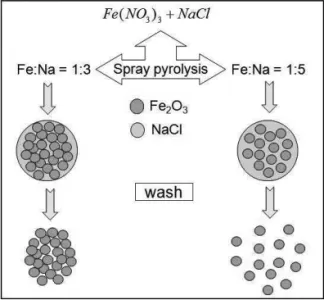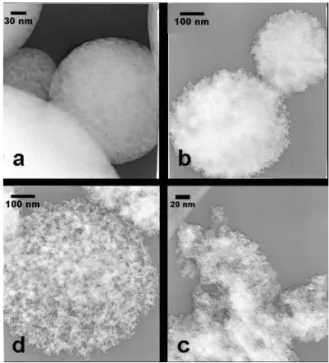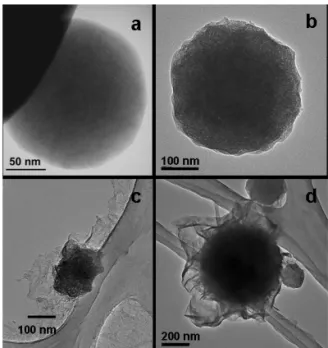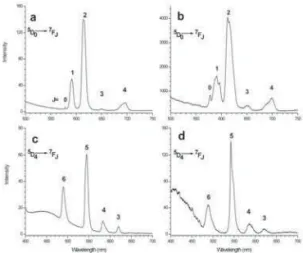Nanocomposites Materials Generated from a Spray.
R.F.C. Marques, J.M.A. Caiut, C.O. Paiva-Santos, S.J.L. Ribeiro, and Y. Messaddeq Institute of Chemistry, UNESP, Araraquara-SP, 14801-970, Brazil
C. Garcia, D. Neumeyer, H. Dexpert, M. Verelst, and J. Dexpert-Ghys Centre d’Elaboration de Mat´eriaux et d’Etudes Structurales UPR 8011,
CNRS-Universit´e Paul Sabatier, 29 Rue Jeanne Marvig, F 31055 Toulouse Cedex 4, France∗ (Received on 1 July, 2008)
The Spray Pyrolysis (SP) process has been employed at moderate temperature (470-970 K) for the synthesis of micro- and nano-particles of hydrated metal oxides and of related nanocomposites. It has been applied to iron nitrate solutions, without or with the addition of sodium chloride as a flux. After removal of the flux, nanocomposites of ferrihydrite (5Fe2O3,9H2O) / hematite (α- Fe2O3) / and an amorphous Fe2O3are obtained,
with surface area 140 m2/g. It has been applied also to a sol of Aluminum-tri-sec-butoxide, without or with activation by europium or terbium ions. Boehmite (γ-AlOOH) powders are synthesized at 470 K, with surface area equal to 180 m2/g. Transition alumina (
γ-Al2O3) are synthesized at 970 K. Nanocomposites made by
reaction of the boehmite orγ-Al2O3particles with the amino acid asparagin (ASN) have been prepared and
characterized. The luminescence of the Eu3+ or Tb3+
doped nanocomposites has been investigated: they can be considered as bio-compatible luminescent nanoparticles.
Keywords: Spray-pyrolysis, Nano-powders, Ferrihydrite, Hematite, Boehmite, Alumina.
I. INTRODUCTION
Spray Pyrolysis (SP) is an aerosol process commonly used to form a wide variety of materials in powder form including metals, metal oxides, ceramics, superconductors, etc ... One of the major advantages of SP is the flexibility: pyrolysis may be conducted at high temperatures (1270 K or more) so that high temperature phases may be achieved in one step. Alter-natively, the whole process may also be conducted at lower temperature: it may then be described as a rapid drying of the spray. In the past years, we intended to take benefit of this flexibility in order to synthesize sub-micrometric or nanomet-ric particles in a wide range of chemical compositions and considering a wide range of possible applications [1–6] Sub-micronic phosphor powders for plasma display applications were synthesized and post-annealed [1, 2], nanometric pow-ders of zincite ZnO for cosmetic applications were synthe-sized by SP of mixtures of zinc and lithium (or sodium) ni-trates [3]; sub-micronic particles of boehmite (AlOOH) were obtained by spray-drying of an aluminium alcoolate[4], these particles spontaneously dispersed in water to form stable sus-pensions of boehmite nanoparticles that could be doped with photo luminescent lanthanide ions, then surface-modified to become bio-compatible [5, 6] . The purpose of the present paper is to show how SP, conducted at moderate tempera-ture,may be used for the synthesis of highly divided, highly reactive metal (here Fe or Al) hydroxides and oxides powders. Iron oxyhydroxides and oxides are of technological impor-tance as catalytic materials, sorbents, pigments, floculents, coatings, gas sensor and ion exchanger [7]. Among them, ferrihydrite is a natural material present in many near surface environments [8, 9]. Due to its high surface area and reac-tivity, ferrihydrite plays an important role in the sequestration of contaminants from groundwater. Adsorption on ferrihy-drite is commonly used to arsenate sequestration from soils,
∗Electronic address:jeannette.dexpert@cemes.fr
groundwater and surface water system [10]. Ferrihydrite is the first phase to precipitate during hydrolysis of Fe3+
ions in solution. Its rough formula is 5Fe2O3,9H2O. Its exact for-mula is still being debated, as is controversial also its exact crystal structure (see for instance [11, 12]). This is not really surprising since the synthesis conditions have a great impact on the average crystal size and on the reactivity towards wa-ter of these nanocrystalline mawa-terials. Among the huge lit-erature dealing with structural characterizations, we selected the multiple structural phases model described by Jansen et. al. [13] and revisited by Y. Cudennec et al. [14]. Ferrihy-drite is metastable and generally considered as goethite α-FeO(OH) or hematiteα- Fe2O3precursor, depending on pH and/or temperature. Hematite is the end-product of thermal decomposition of ferrihydrite in oxidative atmosphere [15]. Hematite has been demonstrated as a potential catalyst for many environmental application including oxidative removal of carbon monoxide or methane combustion. Currently in the market, NANOCAT superfine Fe2O3nanoparticles (sup-plied by Mach-I Inc.) are composed of a mixture of amor-phous and crystalline structures. The higher catalytic activ-ity of NANOCAT than others commercially available Fe2O3 (hematite) is ascribed to its amorphous constituents.
con-trast to microcrystalline or well crystallized boehmite. The nanocrystalline boehmites exhibit crystallite size less than 10 nm, defects and numerous adsorbed water molecules: these features strongly depend on the preparation conditions [20]. The so-called transition aluminas, refer to the group of par-tially dehydrated aluminium hydroxides other than anhydrous α-alumina (corundum). The diffuse characteristic of the pow-der patterns reflects a high degree of structural disorpow-der in the transition aluminas. The transition aluminas are widely used in industry as adsorbents, catalysts or catalyst carriers, coat-ings and soft abrasives because of their fine particle size, high surface area and the catalytic activities of their surfaces.γ-Al2O3is the first transition alumina obtained by thermal de-composition of the boehmite[21, 22].
One aim of this work is to investigate the possibility to ob-tain by SPα- Fe2O3/ferrihydrite spherical and mesoporous-like structures. Consequently, we propose an alterna-tive material to commercially available NANOCAT product. Nanocomposites particles are generated from a precursor so-lution containing Fe(NO3)3,9H2O and NaCl. Herein are in-vestigated the influence of NaCl in the iron nitrate precursor solution and of other operating conditions on the nature, the structure, the morphology and the crystallinity of the pow-ders. Another aim is to synthesize by SP boehmite and tran-sition aluminas as highly divided nanometric powders. The nanometric and/or sub-micronic hydrated aluminas are highly reactive, especially towards amino acids (AA). The nanocom-posite hybrids made of boehmite or alumina with the aspara-gin (ASN) have been studied and characterized as described herein. One possible application of these nanoparticles is lu-minescent bio-labelling after their activation by an emissive lanthanide ion (Eu3+
, Tb3+
). Data concerning their optical spectroscopy are described and discussed.
II. EXPERIMENTAL
Samples are prepared by the spray pyrolysis process which is based on an aerosol formation. An intense ultrasonic source close to the liquid surface will produce a geyser, resulting in an aerosol formation due to cavitations effects on the liq-uid surface. The aerosol, formed by the precursor droplets in an air stream, is conducted through a dry zone at 370-1390 K, then a decomposition-densification zone which can be maintained in the range 570- 1470 K. Collection of the dried powders is achieved by a home made electrostatic col-lector. The ultrasonic generator operates at 2.4 MHz. The ad-justable operating parameters are the flow rate (by which the residence time in the furnace is controlled), the temperature in decomposition zone Tsyn, and of course the nature of the
pre-cursor solution. Spheres composed byα- Fe2O3/ferrihydrite nanoparticles are obtained through spray pyrolysis of a pre-cursor solution containing Fe(NO3)3,9H2O and NaCl as a flux. The idea is to obtain spheres constituted of two phases: the iron oxide phase and a water soluble phase (NaCl). The as-prepared composite spheres are washed several times in water to remove NaCl and the iron oxide is recovered, as schematized in Figure 1. Tsynis fixed at 660 or 820 K. For the
alumina-based compositions, the precursor solution is pre-pared following the methodology established by B. Yoldas [18, 19]. A stable sol of Aluminum-tri-sec-butoxide is diluted
FIG. 1: schematic representation of iron oxide nanoparticles synthe-sized by SP using a soluble flux (NaCl).
in water to concentration 0.2 mol/L of Al3+
, and poured into the vessel over the piezoelectric pellet. Tsyn is fixed at 470
or 970 K. Activation by optically active ions (Eu3+ orTb3+
) is achieved by addition of 2% ([Eu] or [Tb])/[Al] to the dis-tilled water before addition of the aluminum-tri-sec-butoxide. For all SP syntheses, the air flow is 0.3 m3/h, the residence time in the drying zone is 3-4 seconds and about 6-8 sec in the decomposition-densification zone. Amino-Acids - alu-minoxanes nanocomposites have been obtained by dispers-ing the aluminium oxyhydroxide or oxide particle from SP in asparagines water solutions, under agitation for 12 hours. Adsorption/desorption isotherms have been performed by us-ing a Belsorp-mini (BEL Japan Inc. apparatus), between 0 and 99 P/P0 of nitrogen and at 77 K after a pre-treatmet at 353 K under vacuum during 2 hours. Thermal analyses have been performed in a Labsys TG/DTA (SETARAM) anal-yser in an alumina crucible at 5 K/min, under oxygen. The size, the morphology and the crystalline structure of the par-ticles have been studied by transmission electron microscopy (TEM) on a Philips CM12 microscope. The crystalline struc-tures of samples have been investigated by X ray powder diffraction (Seifert XRD 3000 diffractometer) and the quan-titative phases analysis obtained by Rietveld refinements [23] using the program GSAS [24]. In order to obtain a internal standard without microstrain and with a high average crys-tallite size, the 99,99 % cerium oxide is fired at 1570 K for 48 h. Room temperature luminescence excitation and emis-sion spectra have been measured by a Hitachi Fl100 spectro-fluorimeter at 2.5 nm spectral resolution.
III. RESULTS AND DISCUSSION
A. Iron oxyhydroxides and oxides.
sample [Fe] [Na] Fe:Na Tsyn XRD
FE1 0.15 — — 820 HEM
FE2 1.0 — — 820 HEM
FE3 1.5 — — 820 HEM
FENA1 0.15 0.45 1:3 820 HEM+FEH+NaCl FENA2 0.15 0.45 1:3 660 HEM+FEH+NaCl+NaNO3
FENA3 0.10 0.50 1:5 820 HEM+FEH+NaCl
TABLE I: experimental synthesis conditions for iron-based samples: [Fe] and [Na] in mol.L−1, T
synin K, XRD: crystalline phases
iden-tified (HEM=α−Fe2O3, FEH=ferrihydrite)
FIG. 2: TEM images of samples FE1(a); FeNa2(b); FENA2-washed (c), and FENA1-washed (d)
XRD peaks observed for this sample may be indexed with hematite (α- Fe2O3- PDF no 89-2810), as shown in figure 3. The XRD patterns of as obtained samples FENA 1-3 display well defined narrow peaks superposed on broad components. Hematite is detected, together with NaCl for the three sam-ples and with NaNO3in sample FENA2 synthesized at 660 K. This results from the reaction of nitrate species freed by the iron precursor with sodium ions. Nitrate species are evolved when the synthesis is conducted at higher temperature (820 K). These observations prove the complexity of the SP syn-thesis during which occur in a limited range of time the solute precipitation, the solvent evaporation and chemical reactions between the constituents in each droplet [25]. After water washing, XRD patterns of soluble phases NaCl and NaNO3 are not observed, the diffraction diagrams exhibit the peaks ofα- Fe2O3and broad features assigned to hydrated species (ferrihydrites) as discussed below.
The particles of samples FENA1-3 are spherical and sub-micrometric. The spheres observed are nanocomposites made of the iron salts and the sodium salts (Figure 2b). For sam-ple FENA3, obtained with the Fe:Na ratio 1:5, some NaCl cubic-like aggregates are also observed. These cubic aggre-gates are no more observed after washing the sample in water. After wash, highly porous aggregates, retaining the spher-ical shape of the nanocomposite particles are observed by TEM for FENA1 (Figure 2d), but hardly seen for FENA2,
FIG. 3: XRD analysis. Sample FE1 and calculated diagram for hematiteα-Fe2O3.
washed (Figure 2c), same for FENA3 washed (not shown). These observations suggest first that at higher Tsyn, (820 for
SPNA1 versus 660 K for SPNA2), the individual nanopar-ticles start to coalesce during the spray pyrolysis, and the formation of necks prevents desagglomeration of the spheres during washing. Another important parameter is the Fe:Na ratio in the precursor: despite of being obtained at Tsyn= 820
K, aggregates of nanoparticles in FENA3 after wash are no more spherical, suggesting that the high NaCl concentration has not allowed enough contact among iron-based nanopar-ticles so that necks could not be formed prior to dissolution of the NaCl flux. Therefore, by carefully adjusting Fe:Na ra-tio and furnace temperature, sub-micronic spheres of iron ox-ides nanoparticles can be obtained through spray pyrolysis. The N2adsorption-desorption isotherms of samples FENA1 (washed) have been measured: it comes that the surface area is 140±15 m2/g. Compared to sample FE1, the XRD pat-tern recorded for sample FENA1 after wash exhibits signifi-cantly broadened peaks which can be assigned to poorly crys-talline ferrihydrite, superimposed to the narrower diffraction peaks of hematite. Hematite is the end-product of thermal de-composition of the complex ferrihydrite. At same Tsyn(820
FIG. 4: XRD analysis.Sample FENA1 washed + internal standard CeO2; Rietveld simulation.
thermal analysis between 300 and 920 K is 7±0.14 weight % , which is consistent with the previous estimation. In turn, it proves that the composition of the amorphous phase is an-hydrous Fe2O3.
phase amorphous HEM FEH(P3) FEH (P-31c)
weight% 41 27 11 21
H2Oweight% — — 1.85 3.55
TABLE II: sample FENA1 (washed): Refined phases weight% HEM =α-Fe2O3, FEH=ferrihydrite
B. Aluminium oxyhydroxides and oxides.
The synthesis method selected to elaborate by SP the alu-minium based samples is in fact the fast drying of a colloidal solution of boehmite, in order to stop the sol-gel process prior to the long range ordering of the solid phase. The elabora-tion condielabora-tions, the crystal phases identified and some typical properties of the samples are gathered in table III. As for the previous case, the SP synthesis produces NPs agglomerated in sub-micronic spheres. The measured surface area is high: 180±15 m2/g (sample AL200). The sample elaborated at the lower temperature (AL200) exhibits the XRD pattern of nanocrystalline boehmiteγ -AlOOH (Figure 5). It may be spontaneously dispersed in water. In ref.[5] we have shown that the rapid drying (a few seconds) of the sol stops the de-velopment of the aluminium hydroxide network at the level of a few crystal cells. Half the hydroxyl groups are in fact at the external surface of the crystallites. This resulted in a very large number of surface hydroxyls free for water adsorption, actually the chemical composition of SP nano crystallized boehmite is AlOOH,(1.18±0.24) H2O. The very hydrophilic nature of the surface of SP- boehmite crystallites is at the ori-gin of their ability to form stable suspensions in water. When the synthesis is performed at higher temperature (AL700), the XRD peaks are still broader and fit well with what is reported in literature as the transition aluminaγ-Al2O3. AL700 pow-der precipitates in water. Nanocomposites obtained by
reac-FIG. 5: XRD patterns of samples AL200 (a), AL700 (b), AL200-ASN (c), AL700-AL200-ASN (d).
FIG. 6: TEM images of samples AL200 (a), AL700 (b), AL200-ASN (c), AL700-AL200-ASN (d).
tion with ASN behave the same way with respect to disper-sion. The interactions between the ASN and the particles sur-faces are imaged in Figure 6. The AL200 (boehmite) spheres have a smooth surface (Figure 6a), whereas the Al700 (γ-Al2O3) are less regular, and denser (Figure 6b). After reaction with ASN at molar ratio ASN:Al = 0.3:1 and drying, most of the boehmite spheres have disaggregated and the sample looks like a film in which are dispersed nanoparticles. Alu-minium is identified by local analysis (EDXS in TEM) for all parts of the film, and the XRD is that of boehmite. The TEM image selected here (Figure 6c) shows the composite film and one mineral bigger particle not completely destroyed. For the transition aluminas AL700-ASN (Figure 6d), the mixing of the ASN and of the mineral part is less intimate: one observes an organic film wrapping the sub micronicγ-Al2O3particles.
The peculiar emission of Eu3+
sample XRD Tsyn morphology water dispersion
AL200 BOEH 470 spheres, stable sub-µm
AL700 TA 970 spheres, precipitated sub-µm
AL200-ASN BOEH — organic film + stable BOEH NPs
AL700-ASN TA — spheres + precipitated film at surface
TABLE III: Aluminium-based samples : synthesis temperature Tsyn
(K), crystalline phases BOEH=γ-AlOOH, TA=γ-Al2O3,
morphol-ogy and stability in water.
FIG. 7: Photoluminescence emission spectra recorded at room T, spectral resolution 2.5nm. Excitation at 394nm, samples Al200:Eu-ASN (a) and Al700:Eu-Al200:Eu-ASN (b); excitation at 250nm, samples Al200:Tb-ASN(c) and Al700:Tb-ASN (d)
the well known5D0→7F0−4emissions in the visible wave-length range for both samples, the changes observed in the details of the spectra exemplify the possibility to make use of Eu3+
as a local structural probe. Eu3+
inγ-Al2O3exhibits larger splitting than inγ-AlOOH for all the transitions (par-ticularly visible for5D0→7F1), which traduces that the av-erage crystal field acting on Eu3+
is higher in the case of γ-Al2O3. The Eu3+
excitation spectra (not shown here) exhibit the intra-4f6narrow excitation lines and a broad absorption to the Eu—O charge transfer state (CTS). Inγ-Al2O3, as it is ob-served also in most of the oxide matrices, excitation in CTS is more powerful than intra-4f6 excitation, but it is remark-ably inefficient inγ-AlOOH. It is not clear if the band shifts at lower wavenumbers for the boehmite samples or if absorption to the CTS is simply less intense, in any case this effect tra-duces that the oxygen to metal interaction is weaker in doped boehmite than it is in dopedγ-Al2O3. The third point is that the5D0→7F0−4emissions are in-homogeneously broadened in transition alumina, much more than in boehmite, showing that the Eu3+
ions are in numerous different environments in the highly porousγ-Al2O3.
These spectroscopic characteristics have been interpreted in [4, 5] as follows: partly hydrated europium ions are
di-rectly bonded to OH groups at the boehmite surface, and are well maintained at the NPs surface in the nanocomposites. In the transition alumina, Eu3+
ions enter (at least partly) the structure and are linked via Al–O–Eu bonds. The interaction with ASN does not modify the spectra. Terbium (Tb3+
) is also well known to be a good photoluminescent emitter in the green range (540 nm). We have synthesized and investigated the analogous nanocomposites with this ion: Al200:Tb-ASN (Tb:Al = 0.02:1, ASN:Al =0.3:1) and Al700:Tb-ASN. The corresponding emission spectra are recorded in Figure 7 c, and d, respectively. There is no difference between the two spectra because Tb3+
is not really a good structural probe at the low spectral resolution employed here. Due to the simi-larities of chemical properties along the lanthanides series, it seems reasonable to assume that Tb3+
ions behave the same way that Eu3+
ions as for their interaction with the aluminium oxide matrix and with the ASN. Further work is in progress because in fact it appears that the physico-chemical interac-tions in the ternary systems aluminate (boehmite or transition alumina) - lanthanide - ASN are not exactly the same for the two lanthanides Eu and Tb. Nevertheless it may be noticed that luminescent nanocomposites emitting in the green range and stable in water may be obtained from SP synthesis.
IV. CONCLUSION
We have shown how Spray Pyrolysis conducted at moder-ate temperature (from 470 to 970 K in the decomposition-densification area) may be employed for the synthesis of highly divided, highly reactive metal (here Fe or Al) hy-droxides and oxides powders. Two different synthesis strate-gies have been explored. In the case of iron-based ox-ides, a soluble flux (NaCl) has been added to the precur-sor (Fe(NO3)3) in water solution. Under controlled synthesis conditions, after removal of the flux, nanocomposites of fer-rihydrite (5Fe2O3,9H2O) / hematiteα- Fe2O3/ and an amor-phous Fe2O3 are obtained, with surface area 140 m2/g. In the case of aluminium-based oxides, an Al-alcoholate pre-cursor has been preferred, in order to get only the boehmite γ -AlOOH (at the lower temperature) or the transition alu-minaγ-Al2O3. Boehmite powders are obtained with surface area equal to 140 m2/g that can be easily dispersed in wa-ter. Nanocomposites made by reaction of the boehmite or γ-Al2O3particles with the amino acid asparagin (ASN) have been investigated. These nanocomposites have been doped with a lanthanide ion (Eu3+
or Tb3+
), and their luminescence investigated since they can be considered as bio-compatible luminescent nanoparticles.
Acknowledgments
The authors acknowledge the FAPESP, and the CAPES-COFECUB Brazil-France cooperation program for financial support.
[1] N. Joffin, J. Dexpert-Ghys, M. Verelst, G. Baret and A. Garcia, J. Lumin.113, 249 (2005).
A.Garcia, P. Guillot, J. Galy, R. Mauricot and S. Schamm, J. Phys. D.38, 3261 (2005).
[3] C. Rossignol, M. Verelst, J. Dexpert-Ghys and S. Rul, Adv. Sci. Tech.45, 237 (2006).
[4] J.M.A. Caiut, J. Dexpert-Ghys, Y. Kihn, M. Verelst, H. Dex-pert, S.J.L. Ribeiro and Y. Messaddeq, Powder Techn. 190 , 95-98 (2009).
[5] J.M.A. Caiut, S.J.L. Ribeiro, Y. Messaddeq, J. Dexpert-Ghys, M. Verelst and H. Dexpert, Nanotech.18, 455605 (2007). [6] J.M.A. Caiut, L. Bazin, R. Mauricot, H. Dexpert, S.J.L. Ribeiro
and J. Dexpert-Ghys, J. Non Cryst. Sol. 35, 4860–4864 (2008). [7] F. Schuth, Chem. Mater.13, 3184 (2001).
[8] D. G. Rancourt, D. Fortin, T. Pichler, P.J. Thibault, G. Lamarche, R.V. Morris and P.H.J. Mercier, Am. Mineral.86, 834 (2001).
[9] U. Schwertmann, L. Carlson and E. Murad, Clays Clay Miner. 35, 297 (1987).
[10] Y. Jia, L. Xu, X. Wang and G.P. Demopoulos, Geochim. et Cosmochim. Acta71, 1643 (2007).
[11] R.L. Penn, Science316, 1704 (2007).
[12] F.M. Michel, L. Ehm, S.M. Antao, P.L. Lee, P.J. Chupas, G. Liu, D.R. Strongin, M.A. A. Schoonen, B.L. Phillips and J.B. Parise, Science316, 1726 (2007).
[13] E. Jansen, A. Kyek, W. Schfer, U. Schwertmann, Appl. Phys. A,74, 1004 (2002).
[14] Y. Cudennec, A. Lecerf, J. Solid State Chem.179, 716 (2006). [15] R.M. Cornell and U. Schwertmann, The Iron Oxides, Structure, Properties, Reactions, Occurrence and Uses (WCH, Weinheim, New York, Basel, Cambridge, Tokyo, (2004)).
[16] A. Pearson, Aluminium oxide, activated, in Kirk-Othmer En-cyclopedia of Chemical Technology (J. Wiley, New York, 2, 291 (1994)).
[17] C. Misra, Aluminium oxide, hydrated, in Kirk-Othmer Ency-clopedia of Chemical Technology (J. Wiley, New York, 2, 317 (1994))
[18] B. E. Yoldas, Ceramic Bull.54:3, 289 (1975). [19] B. E. Yoldas, J. Mater. Sci.10, 1856 (1975).
[20] M. Nguefack, S. Rossignol, A.F. Popa, and C. Kappenstein, Phys. Chem. Chem. Phy.5, 4279 (2003).
[21] R.S. Zhou, R.L. Snyder, Appl. Crys.47, 617 (1991).
[22] K. & MISRA, C.. Alcoa Technical Paper 19, revised. Alcoa Laboratories, Pittsburg, PA, USA. (1987)
[23] H.M. Rietveld, J. Appl. Crystall.2, 65 (1969).
[24] A.C. Larson and R.B. Von Dreele, Los Alamos National Labo-ratory. Los Alamos , EUA. Copyright, 1985-2000, The Regents of the University of California, 2001.



